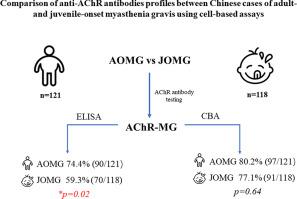当前位置:
X-MOL 学术
›
J. Neuroimmunol.
›
论文详情
Our official English website, www.x-mol.net, welcomes your
feedback! (Note: you will need to create a separate account there.)
Comparison of anti-acetylcholine receptor profiles between Chinese cases of adult- and juvenile-onset myasthenia gravis using cell-based assays
Journal of Neuroimmunology ( IF 2.9 ) Pub Date : 2020-12-01 , DOI: 10.1016/j.jneuroim.2020.577403 Chong Yan , Rui Zhao , Jie Song , Xuelin Feng , Jianying Xi , Sushan Luo , Huahua Zhong , Shuizhen Zhou , Wenhui Li , Chongbo Zhao
Journal of Neuroimmunology ( IF 2.9 ) Pub Date : 2020-12-01 , DOI: 10.1016/j.jneuroim.2020.577403 Chong Yan , Rui Zhao , Jie Song , Xuelin Feng , Jianying Xi , Sushan Luo , Huahua Zhong , Shuizhen Zhou , Wenhui Li , Chongbo Zhao

|
OBJECTIVE
Juvenile-onset myasthenia gravis (JOMG) is a unique clinical subtype in China, featured by a higher prevalence of ocular myasthenia gravis (OMG), higher seronegativity of acetylcholine receptor (AChR) antibodies, and better prognosis than that in adult-onset myasthenia gravis (AOMG). We previously identified low-affinity AChR antibodies in Chinese JOMG patients using cell-based assays (CBAs), indicating a predominantly AChR antibody-positive profile. Here, we further screened AChR antibodies in both Chinese AOMG and JOMG patients by CBAs. MATERIALS AND METHODS
We recruited patients with MG who had not received prednisone or immunosuppressive therapies between June 2015 and June 2019, and divided them into AOMG and JOMG subgroups according to their ages at the time of recruitment. Clinical information and blood samples were collected. Serum AChR antibodies were detected by CBAs in HEK293T cells expressing clustered adult and fetal AChRs, as well as by enzyme-linked immunosorbent assays (ELISAs). Differences in AChR antibody profiles between AOMG and JOMG subgroups were determined. RESULTS
A total of 239 patients with MG were enrolled in the present study, including 121 AOMG and 118 JOMG patients. Based on ELISAs, 74.4% of AOMG (90/121) and 59.3% of JOMG (70/118) patients were anti-AChR positive (p = 0.02). However, CBAs yielded equal anti-AChR positivities (p = 0.64), as indicated by 80.2% of AOMG patients (97/121) and 77.1% of JOMG patients (91/118). Furthermore, among AOMG patients, 67.8% (82/121) were positive for both adult and fetal AChR antibodies, 5.8% (7/121) were positive for only adult AChR antibodies, and 6.6% (8/121) were positive for only fetal AChR antibodies, while these rates were 50.8% (60/118), 21.2% (25/118), and 5.1% (6/118), respectively, in JOMG cohorts (p < 0.01). Twenty-nine AOMG patients and 10 JOMG patients underwent IgG subclassification of AChR antibodies, which were all confirmed to be predominantly IgG1. CONCLUSIONS
The positive rates of AChR antibodies did not differ between Chinese AOMG and JOMG patients, as revealed by CBAs. Furthermore, the screened AChR antibodies were predominantly IgG1 in both AOMG and JOMG patients.
更新日期:2020-12-01











































 京公网安备 11010802027423号
京公网安备 11010802027423号